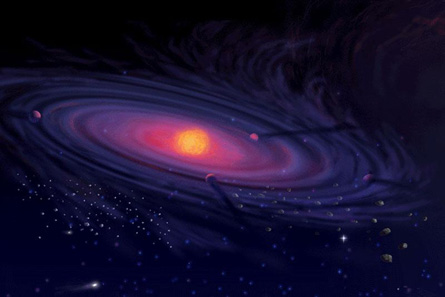NANTES, France — Call it the battle of the planet creationists.

On one side of the ring stands Doug “Rocky Core” Lin. On the other side stands Alan “Jupiter in a Hurry” Boss. For more than a decade, Lin, a theorist at the University of California, Santa Cruz, has argued with Boss, a theorist at the Carnegie Institution of Washington (D.C.), over the correct theory of planet formation.
Lin champions what is generally viewed as the standard model, known as core accretion. In this model, grains of dust lying within the disk of gas and dust that surrounds a young star gather together to form solid chunks of rock. Then some of these bodies are destined to become rocky planets like Earth; others cloak themselves in a massive envelope of gas and form gas giants like Jupiter. But one problem with this gradual, two-step recipe for making a Jupiter is that the gaseous disk may evaporate before the process finishes.
In the early 1990s, Boss proposed an alternate model, called gravitational instability, in which gas giants form wholesale from a sudden fragmentation of the disk. No gradual buildup is required.
Lin says he stuck his neck out in a public debate with Boss in San Diego a few years ago and made a prediction about the arrangement of extrasolar planets not yet found, a prediction only the core accretion model could support.
On June 16, during a workshop in Nantes, France, on superEarths — rocky extrasolar planets five to 10 times the mass of Earth — Lin said that a newfound association between these planets and extrasolar Jupiters matches his prediction and provides “an acid test for proving the core accretion scenario.” In his talk, Lin cited the new findings announced earlier that day by researchers based at Geneva Observatory in Switzerland. That team has found several extrasolar planetary systems in which a superEarth closely circles a star, while a Jupiter or Saturn orbits at a greater distance.
Those systems show that superEarths — rocky cores — must have formed first, before the Jupiters, just as the core-accretion model predicts, Lin says.
In Boss’ gravitational instability picture, the gas giants could form much faster than the rocky planets. In that theory, “It would be highly unlikely to form a generation of superEarths before the Jupiters get settled,” Lin notes.
At the conference in France, Jonathan Lunine of the University of Arizona in Tucson said he agrees that the findings support the core-accretion model, at least for making Jupiters in the inner part of the gas and dust disk. Reached by e-mail back in the United States, Boss contends that “these results are also consistent with the predictions of gravitational disk instability, which only operates in the outer disk, outside of the region where the terrestrial planets form.”
Says Lin: “I do not expect Alan to admit defeat and am sure that he will come up with an even more contrived scenario. Just ask him if there will ever be a reason that would make him give up.”







